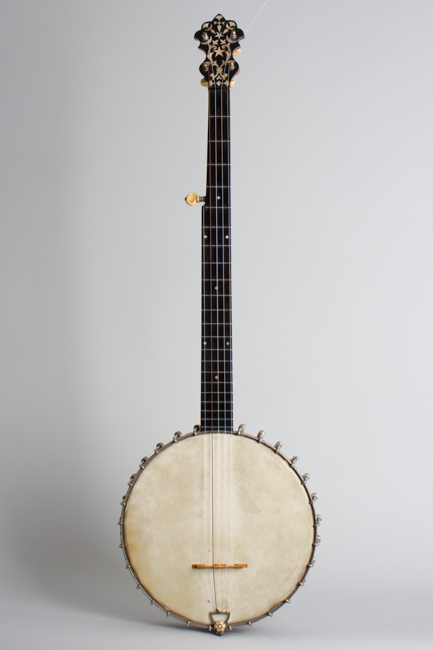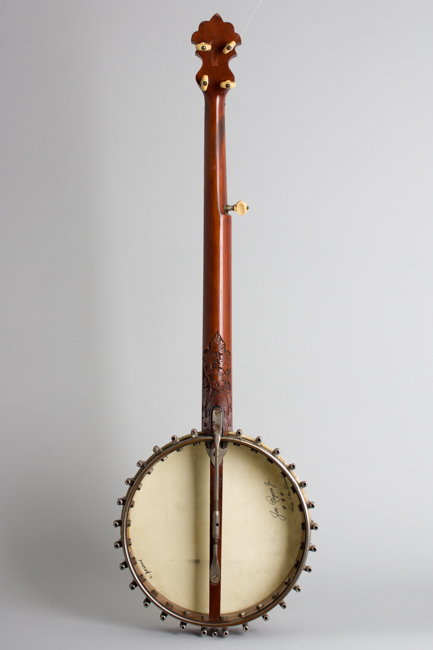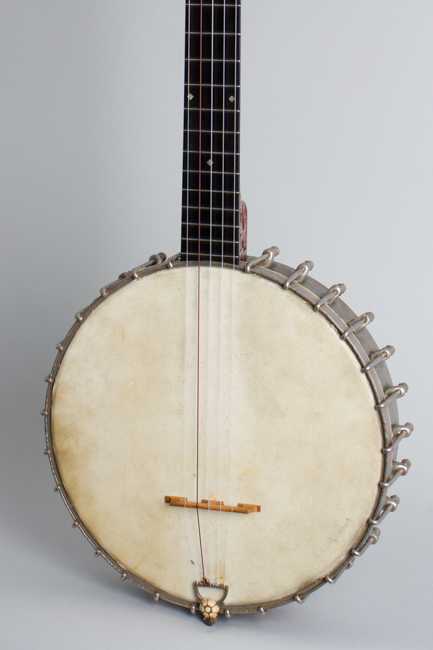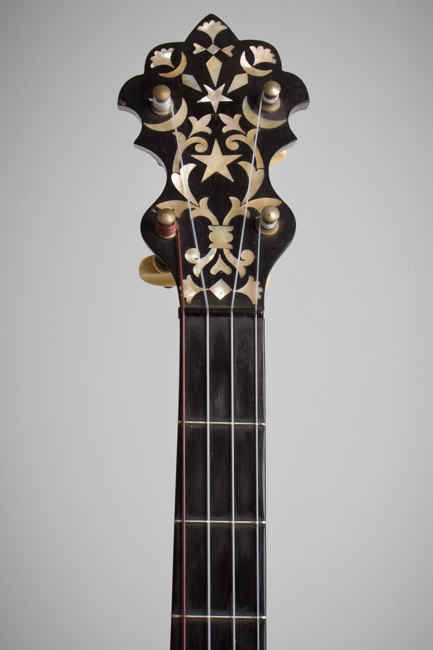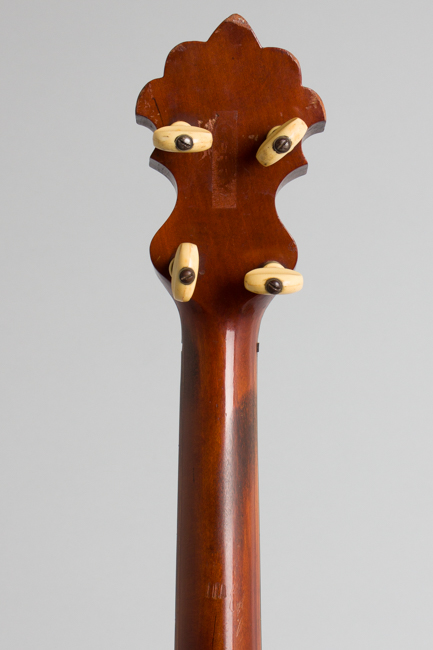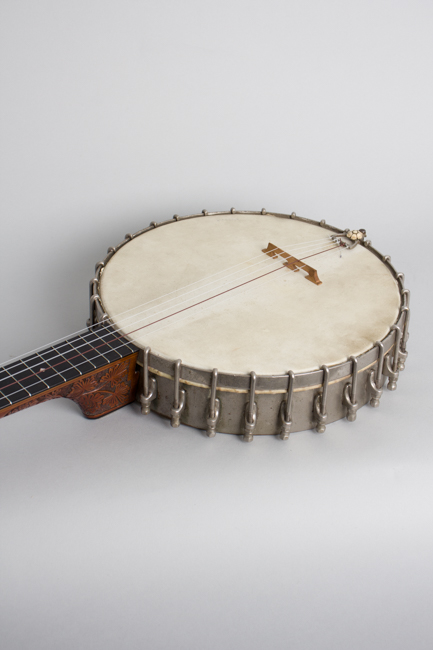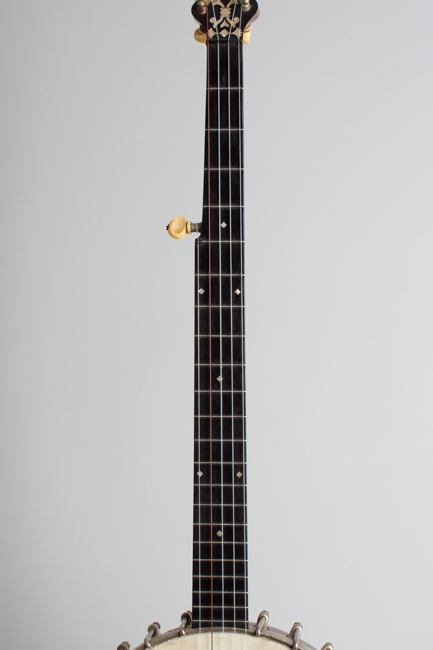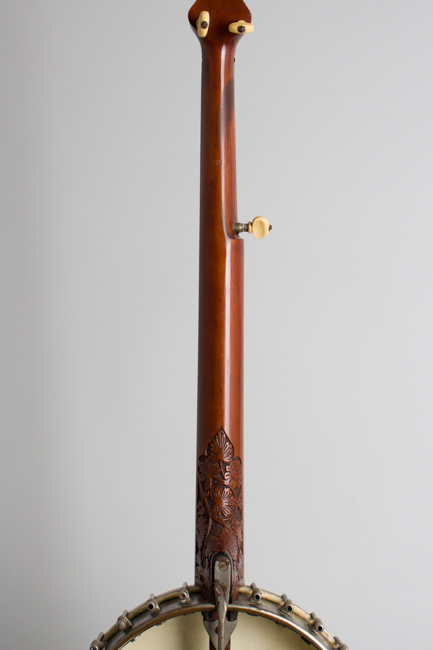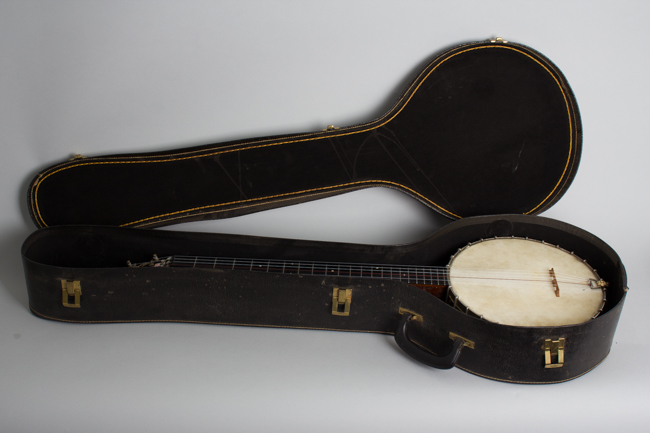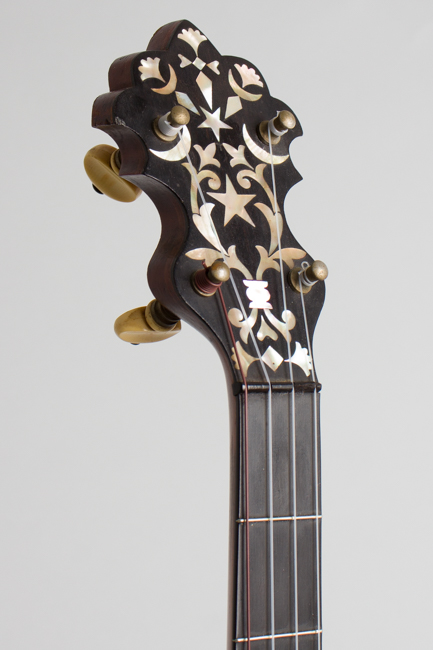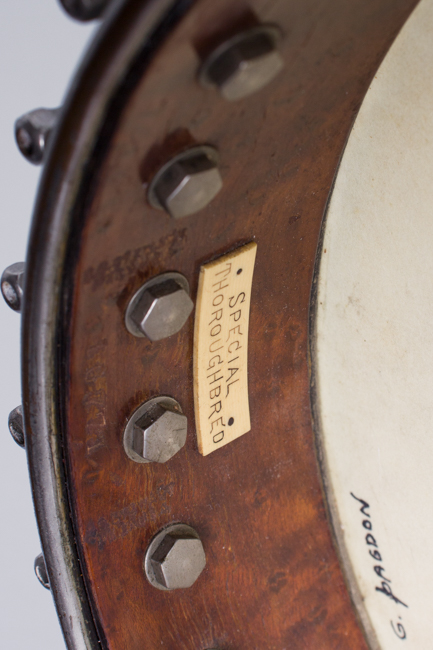S. S. Stewart Special Thoroughbred 5 String Banjo (1896)
This item is currently on hold.
Item # 11153
Prices subject to change without notice.
S. S. Stewart Special Thoroughbred Model 5 String Banjo (1896), made in Philadelphia, PA, serial # 16771, natural varnish finish, spunover rim, cherrywood neck with ebony fingerboard, black chipboard case.
This instrument is an S.S. Stewart "Special Thoroughbred" banjo, made around 1896 when the Philadelphia company was, by their own account at least, the world's greatest banjo maker. This was a fairly unique model built with higher grade materials but devoid of the fancy fingerboard inlay used by most makers in this era. It was endorsed in 1896 by the virtuoso Alfred A. Farland, who was so full of ideas about how the banjo should be made he would shortly launch his own signature instrument line. He wanted a clean playing surface for his elaborate technique, and found the usual profusion of pearl in the better instruments to be an impediment. The "Special Thoroughbred" therefore has only tiny diamond inlay, leaving mostly unbroken ebony for the fingers to dance on.
The other features are fairly high end. This example is built around a 10 5/8" spunover 28 bracket rim with a 26 1/2" scale neck. There is a lovely dense moon-and-stars pearl inlay pattern on the headstock, and the heel is carved in a typical Stewart floral motif. The dowel stick carries an inlayed celluloid "S.S. Stewart, Phil'a PA" logo tag alongside an impressed "SSS" headstock-shaped logo. An ivoroid "Special Thoroughbred" tag is pinned inside the lower rim. The tailpiece is the original "Common Sense" style with the center "walrus ivory" (per Stewart) decorative rosette still intact. The tuners are standard period friction pegs with ivoroid buttons. Stewart's patented turnbuckle neck brace is intact and working; this was one of the earliest such systems.
This model listed at $40 in 1896, which was a high/midline price for Stewart but a considerable sum of money even in the Gilded Age. Stewart was never at a loss promoting his wares; It was described as "made of the choicest selected material, and possesses the quality of musical tone so desirable in a concert banjo". He added it was "made for BANJO PLAYERS exclusively and not novices". For a time the Thoroughbred models were not sold in music stores, but had to be special ordered directly from Stewart's Philadelphia factory.
The banjo shows some wear and tear but remains a nicely original survivor of the first golden era of the 5-string banjo, a true playable antique and a lovely example of S.S. Stewart's work.
Overall length is 35 1/4 in. (89.5 cm.), 10 3/4 in. (27.3 cm.) diameter head, and 2 3/4 in. (7 cm.) in depth, measured at side of rim. Scale length is 26 1/2 in. (673 mm.). Width of nut is 1 3/16 in. (30 mm.).
This banjo remains in nicely original condition showing wear typical for its age, now approaching 130 years old! The finish on the wood is relatively clean overall, with minor dings and a couple of wear spots to the wood lower down on the neck. There is one feelable capo ding behind the third fret, and a few lighter scrapes. The fingerboard and frets show very little wear.
There is some loss and corrosion to the outer plated rim surface, most notable below the neck where some plating is gone down to the metal. The hook and nut set is all period and almost completely original with a couple of just slightly mismatched nuts; there is general plating loss but less corrosion than many.
All other hardware is original, including the tailpiece, neck brace and friction tuners. This banjo, like all early Stewarts, was designed in an era when only gut strings were used on banjos. It is set up with a NylGut classical set and a old funky looking but very solid calfskin head. We would NOT recommend steel strings on this instrument; the cherry neck is quite straight for one of these but not designed for steel string tension. Many old Stewart banjos have been effectively ruined in this way over the last 100 years. Taken as it is, this is a lovely period piece and a fine playing and sounding banjo within its 19th century intentions. Overall Excellent - Condition.
This instrument is an S.S. Stewart "Special Thoroughbred" banjo, made around 1896 when the Philadelphia company was, by their own account at least, the world's greatest banjo maker. This was a fairly unique model built with higher grade materials but devoid of the fancy fingerboard inlay used by most makers in this era. It was endorsed in 1896 by the virtuoso Alfred A. Farland, who was so full of ideas about how the banjo should be made he would shortly launch his own signature instrument line. He wanted a clean playing surface for his elaborate technique, and found the usual profusion of pearl in the better instruments to be an impediment. The "Special Thoroughbred" therefore has only tiny diamond inlay, leaving mostly unbroken ebony for the fingers to dance on.
The other features are fairly high end. This example is built around a 10 5/8" spunover 28 bracket rim with a 26 1/2" scale neck. There is a lovely dense moon-and-stars pearl inlay pattern on the headstock, and the heel is carved in a typical Stewart floral motif. The dowel stick carries an inlayed celluloid "S.S. Stewart, Phil'a PA" logo tag alongside an impressed "SSS" headstock-shaped logo. An ivoroid "Special Thoroughbred" tag is pinned inside the lower rim. The tailpiece is the original "Common Sense" style with the center "walrus ivory" (per Stewart) decorative rosette still intact. The tuners are standard period friction pegs with ivoroid buttons. Stewart's patented turnbuckle neck brace is intact and working; this was one of the earliest such systems.
This model listed at $40 in 1896, which was a high/midline price for Stewart but a considerable sum of money even in the Gilded Age. Stewart was never at a loss promoting his wares; It was described as "made of the choicest selected material, and possesses the quality of musical tone so desirable in a concert banjo". He added it was "made for BANJO PLAYERS exclusively and not novices". For a time the Thoroughbred models were not sold in music stores, but had to be special ordered directly from Stewart's Philadelphia factory.
The banjo shows some wear and tear but remains a nicely original survivor of the first golden era of the 5-string banjo, a true playable antique and a lovely example of S.S. Stewart's work.
Overall length is 35 1/4 in. (89.5 cm.), 10 3/4 in. (27.3 cm.) diameter head, and 2 3/4 in. (7 cm.) in depth, measured at side of rim. Scale length is 26 1/2 in. (673 mm.). Width of nut is 1 3/16 in. (30 mm.).
This banjo remains in nicely original condition showing wear typical for its age, now approaching 130 years old! The finish on the wood is relatively clean overall, with minor dings and a couple of wear spots to the wood lower down on the neck. There is one feelable capo ding behind the third fret, and a few lighter scrapes. The fingerboard and frets show very little wear.
There is some loss and corrosion to the outer plated rim surface, most notable below the neck where some plating is gone down to the metal. The hook and nut set is all period and almost completely original with a couple of just slightly mismatched nuts; there is general plating loss but less corrosion than many.
All other hardware is original, including the tailpiece, neck brace and friction tuners. This banjo, like all early Stewarts, was designed in an era when only gut strings were used on banjos. It is set up with a NylGut classical set and a old funky looking but very solid calfskin head. We would NOT recommend steel strings on this instrument; the cherry neck is quite straight for one of these but not designed for steel string tension. Many old Stewart banjos have been effectively ruined in this way over the last 100 years. Taken as it is, this is a lovely period piece and a fine playing and sounding banjo within its 19th century intentions. Overall Excellent - Condition.
